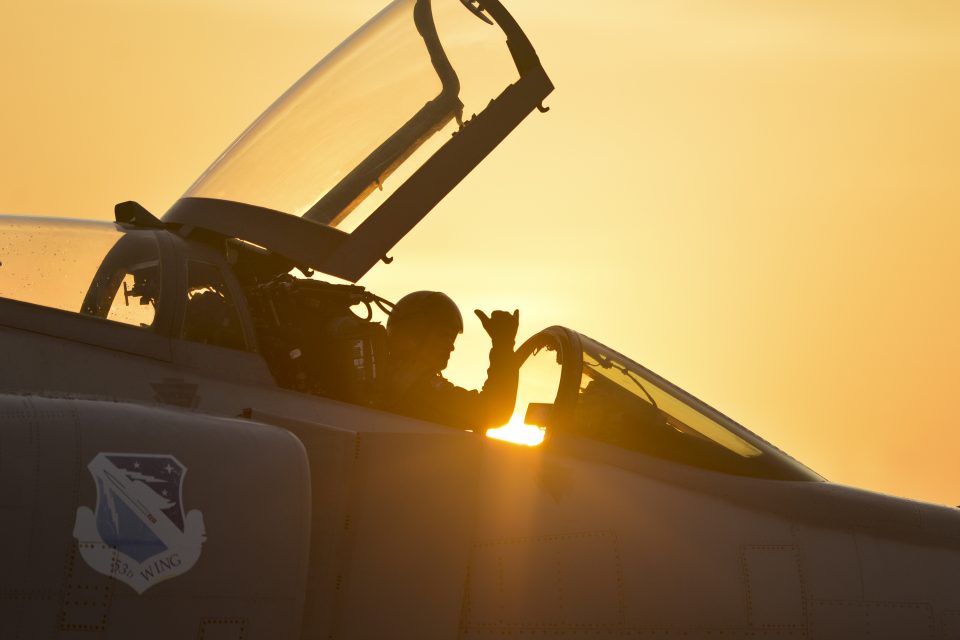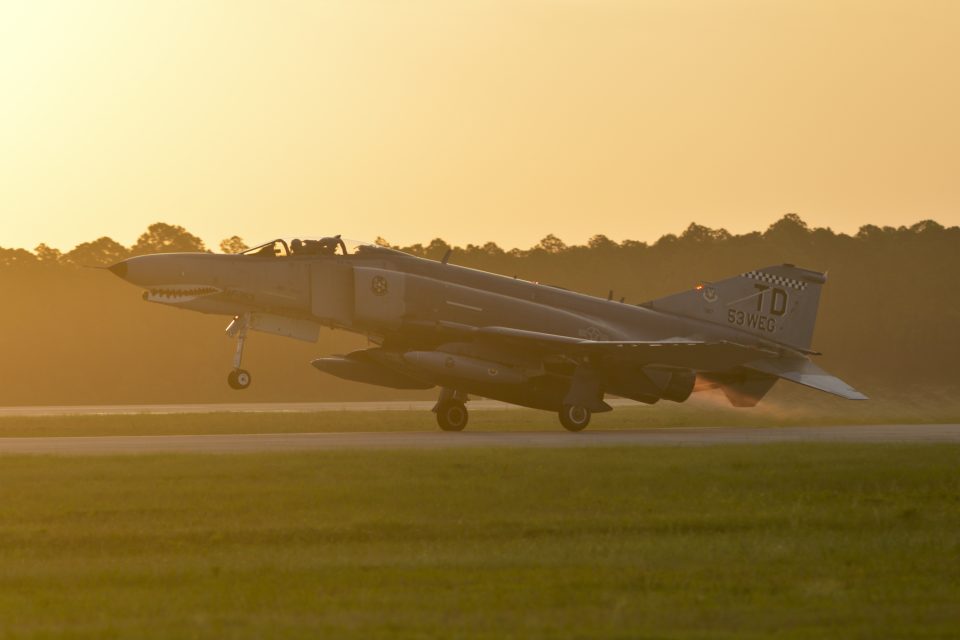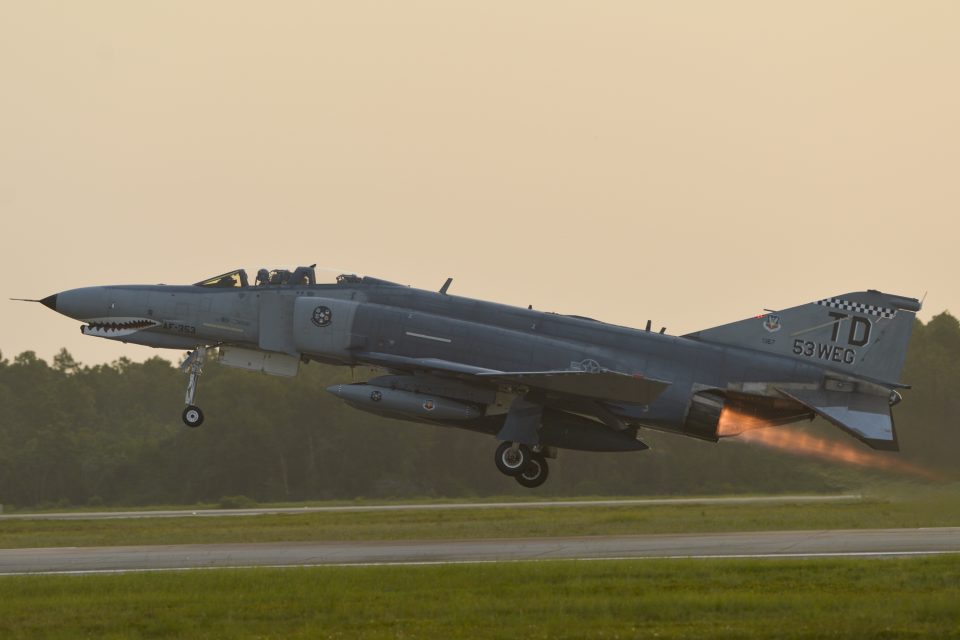2015-07-25 Lt. Col. Todd Houchins, 53rd Test Support Squadron commander, pilots the last 82nd Aerial Target Squadron QF-4 Phantom on Tyndall Air Force Base during the final take off, July 24.
The QF-4 Phantom will travel to Holloman Air Force Base, N.M.
(U.S. Air Force photo by Tech. Sgt. Javier Cruz/Released).
325th Fighter Wing Public Affairs
7/24/15
And a story by Brian Everstine from Air Force Times published on May 30, 2015, described the end of the mission for the F-4s:
The mission for the QF-4 targeting drone is over, with the last of the converted F-4 Phantom IIs destroyed over the Gulf of Mexico.
Since 1997, the Air Force has flown 315 QF-4 drones as targets for training and weapons testing. On Wednesday, the 82nd Aerial Targets Squadron operated the last of the fleet on a training mission out of Tyndall Air Force Base, Florida. The jet was destroyed during a live weapons testing flight, according to base public affairs.
The Air Force’s new fleet of QF-16s, converted Fighting Falcons, will now take over the unmanned targeting drone role. The aircraft, converted block 15, 20 and 30 variants of the F-16, first began unmanned test flights in 2013, with the first production model arriving at the Florida base in March 2015. The service expects to field 210 of the converted jets.
QF-4s, and QF-16s, are outfitted with electronic and infrared countermeasures to fully mimic an adversarial aircraft in training, according to the Air Force.
The aircraft are outfitted with explosive devices to destroy them over a designated area of the sea, should they become uncontrollable during targeting missions.
A pilot operates the aircraft from a ground station, and the drone is followed by a trailing aircraft.
F-4 Supports Mission. Courtesy Video | Defense Media Activity – Air Force | Date: 06.25.2008.
This edition features a story on the retired F-4 Phantom seen assisting the military by using them as an unmanned remote drone to shoot experimental live missiles at for training.
And this 2008 piece written by Ralph Wetterhahn and published in Air and Space Magazine answered the question: Where have all the phantoms gone?
In 1996 the aircraft was retired from the U.S. fleet. But the venerable McDonnell design has one last mission to perform for the military: to go down in flames.
Since 1991, 254 Phantoms have served as unpiloted flying targets for missile and gun tests conducted near Tyndall Air Force Base in Florida and Holloman Air Force Base in New Mexico. The use of F-4 drones (designated QF-4s) is expected to continue until 2014.
When an airframe is needed for target duty, one is pulled from storage at Davis-Monthan Air Force Base in the Arizona desert. The airframe is given refurbished engines and instruments, then sent to Mojave Airport in California. There, BAE Systems turns the aircraft into remote-controlled drones, installing radio antennas and modifying the flight controls, throttles, landing gear, and flaps.
QF-4 production test pilot Bob Kay is responsible for testing the converted aircraft, then flying them from Mojave to Tyndall and Holloman. Kay has been captivated by the F-4 since the age of seven, when his father took him to an airshow. “I saw a Navy A-3 refueling two Phantoms as they flew over so low and with that noise,” he says. “That’s all I remember of that airshow, but I knew I wanted to fly that fighter.”
I ask if he has any second thoughts about being part of a system that destroys an airplane he loves, an aviation legend.
He thinks for a moment, then says, “What better way is there for a warrior to end its life than to go down in a blaze of glory?…..”
Most Phantoms wind up in the Gulf of Mexico within one to three missions. But not all: One, nicknamed “Christine,” after the Stephen King book and film about a crazed car with a mind of its own, had survived 10 missions. Another, “Son of Christine,” has come back from 12 sorties, the current record.
Some drone missions are not meant to be shootdowns: The Phantom is loaded with missile jammers, and missiles without warheads are fired against the craft to test how well the jamming works. Other Phantoms are spruced up with Vietnam War-era camouflage and flown to airshows.
One Phantom was saved by its former pilot. On April 16, 1972, Dan Cherry, flying an F-4D, had scored a victory over a North Vietnamese Mig-21. Thirty-two years later, during a trip with friends to the National Museum of the Air Force in Dayton, Ohio, Cherry encountered the aircraft he had flown that day. It was on display in the little town of Enon, outside Dayton.
“In spite of her flat tires, weeds growing up all around, bird droppings everywhere, and faded gray paint, she was beautiful,” he recalls. “Walking around her and answering my friend’s questions made me realize how much I loved her and how much I owed her for taking such good care of me. Suddenly all those things that seemed like negatives before paled in comparison to the strong bond I felt at that moment.”
Cherry took on the task of relocating the aircraft to the Aviation Heritage Park in Bowling Green, Kentucky, where it was restored and is now displayed. Then he decided to learn about the pilot of the MiG he had shot down.
At Tyndall, the heat and humidity hit my face like a wet washcloth. The van driver took us from Death Row to the end of the runway, where F-4E tail number 73-1165 was positioned about 20 feet to the right of the runway centerline.
I asked if I could approach the aircraft. My unit escort, Major Kevin Brackin, obtained permission. I got out of the van and walked across the concrete. When I reached the aircraft, I placed my hand on the radome. Because of the cloud cover, the nose was warm to the touch, not the usual egg-frying hot. The Phantom felt alive.
I felt a wave of dread. Within minutes this magnificent machine might be in pieces at the bottom of the Gulf of Mexico.
A photo was taken, and I headed back to the van to listen to the radio chatter.
Lee says it cost the Air Force $2.6 million to get the aircraft from the boneyard in Tucson to the runway at Tyndall. Is it worth it? “The F-4E has the built-in ability to launch flares and chaff and can carry an assortment of jamming pods, all of which put our latest weapon systems through their most rigorous tests,” says Lee. Had we taken the time to test our missiles properly in the early 1960s, the Vietnam air war might have turned out like the one over Baghdad: a clean sweep.
We positioned ourselves behind the drone to await the launch order. Both engines were started. The canopy was closed, and the self-destruct bomb was armed for use in case the drone went out of control. Finally, the intake screens in front of the engine inlets were removed.
Then came an ominous ground transmission: The “shooter aircraft have problems,” and a storm cell had slung cloud layers over a wide swath of sky. We sat and waited.
Finally, after a 15-minute delay, the mission was ordered back on.
The drone launch order was soon passed, and the operators got the Phantom rolling. LaCourse made a correction to get the aircraft precisely on centerline as both afterburners lit. Fifteen seconds later, I watched the pilotless aircraft take off.
The F-4 proceeded out over the gulf. The first aircraft fired its missile. The ground controller monitoring the telemetry radioed the air crews: “No hit.”
The Phantom flew on.
My emotions tangled: I wanted the aircraft to survive, but I also wanted it to fulfill its intended mission.
The four F-22 Raptors spread out.
Each launched a missile. Over the radio we heard “Fox-four”—all shooters had fired.
Then: “Splash.” A direct hit.
Brackin and I walked back to the van and got in. Brackin was staring straight ahead.
Then he turned to me. “So now you know,” he said, grinning. “It takes four Raptors to kill an F-4.”
Aug 12, 2008
This is a manned drone practice mission at holloman AFB NM, the drones squadron is based out of Tyndell AFB but operates out of Holloman, the F4 overhead is a chase plane, the remote operated drone is the one touching down.
These are used to test new weapons systems at Holloman.
There is a pilot in the drone for this mission as it is only a practice for the ground opperator.
If it was unmanned we would not be able to be this close due to the drones self destruct explosive mechanism.





